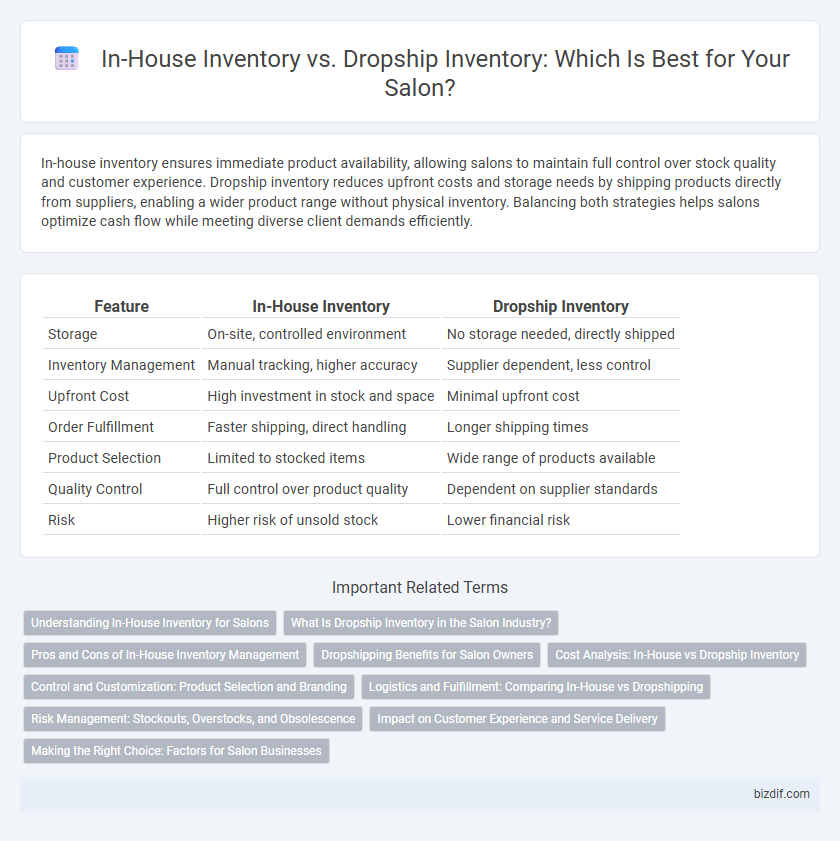In-house inventory ensures immediate product availability, allowing salons to maintain full control over stock quality and customer experience. Dropship inventory reduces upfront costs and storage needs by shipping products directly from suppliers, enabling a wider product range without physical inventory. Balancing both strategies helps salons optimize cash flow while meeting diverse client demands efficiently.
Table of Comparison
| Feature | In-House Inventory | Dropship Inventory |
|---|---|---|
| Storage | On-site, controlled environment | No storage needed, directly shipped |
| Inventory Management | Manual tracking, higher accuracy | Supplier dependent, less control |
| Upfront Cost | High investment in stock and space | Minimal upfront cost |
| Order Fulfillment | Faster shipping, direct handling | Longer shipping times |
| Product Selection | Limited to stocked items | Wide range of products available |
| Quality Control | Full control over product quality | Dependent on supplier standards |
| Risk | Higher risk of unsold stock | Lower financial risk |
Understanding In-House Inventory for Salons
In-house inventory for salons involves storing all beauty products and tools on-site, allowing immediate access and better control over stock levels. This approach enables salons to ensure product availability, provide personalized recommendations, and reduce shipping times for clients. Managing in-house inventory effectively reduces the risk of stockouts and supports prompt service delivery, enhancing overall customer satisfaction.
What Is Dropship Inventory in the Salon Industry?
Dropship inventory in the salon industry refers to a supply chain model where salon products are shipped directly from the manufacturer or wholesaler to the customer, bypassing the salon's physical storage. This approach reduces the need for in-house inventory, minimizes overhead costs, and allows salons to offer a wider range of products without investing in extensive stock. By leveraging dropshipping, salons can streamline operations, improve cash flow, and focus on customer service rather than inventory management.
Pros and Cons of In-House Inventory Management
In-house inventory management in salons allows precise control over product quality and immediate availability, enhancing customer satisfaction and reducing delivery delays. It requires significant upfront investment in storage space and inventory tracking systems, increasing operational costs and risk of overstocking or product expiration. Managing inventory internally enables personalized stock selection aligned with salon branding but demands dedicated staff and regular audits to maintain efficiency and reduce waste.
Dropshipping Benefits for Salon Owners
Dropshipping inventory for salon owners eliminates the need for upfront product investment and storage space, reducing overhead costs significantly. This model allows salons to offer a wider range of beauty products without managing stock, enhancing customer satisfaction through diverse options. Real-time order fulfillment from suppliers streamlines operations, enabling salon owners to focus on service quality and client experience.
Cost Analysis: In-House vs Dropship Inventory
In-house inventory entails upfront costs including purchasing, storage, and management fees, which can tie up significant capital for salons. Dropship inventory reduces these expenses by eliminating storage needs and minimizing inventory holding risks, but it often comes with higher per-unit costs and potential shipping delays. Analyzing cost efficiency involves balancing inventory carrying costs against increased product prices and customer satisfaction impact in the salon industry.
Control and Customization: Product Selection and Branding
In-house inventory offers salons greater control and customization over product selection and branding, enabling tailored stock that aligns with the salon's unique identity and client needs. Dropship inventory limits this control as products are sourced directly from suppliers, restricting branding opportunities and product variety. Managing in-house inventory ensures consistent quality and a personalized customer experience, essential for maintaining a salon's brand reputation.
Logistics and Fulfillment: Comparing In-House vs Dropshipping
In-house inventory offers salons direct control over logistics and fulfillment, enabling faster order processing and customized packaging that enhances client experience. Dropshipping reduces the need for storage and upfront investment by having suppliers ship products directly to customers, but may result in longer delivery times and limited control over packaging quality. Efficient salon operations balance inventory strategies to optimize order accuracy, shipping speed, and cost management.
Risk Management: Stockouts, Overstocks, and Obsolescence
In-house inventory management in salons minimizes the risk of stockouts by maintaining immediate product availability, while dropship inventory reduces the dangers of overstocks and obsolescence through just-in-time fulfillment. Balancing these models helps salons optimize cash flow and inventory turnover rates, ensuring popular items remain in stock without excess unsold products. Effective risk management hinges on accurate demand forecasting and integrated inventory tracking systems to prevent lost sales and minimize waste.
Impact on Customer Experience and Service Delivery
In-house inventory ensures immediate product availability, enabling salons to offer personalized consultations and faster service delivery, which significantly enhances customer satisfaction. Dropship inventory expands product variety without increasing storage costs but may lead to longer wait times and potential delays in order fulfillment. Balancing in-house stock with dropshipping options allows salons to optimize both product accessibility and customer experience.
Making the Right Choice: Factors for Salon Businesses
Choosing between in-house inventory and dropship inventory depends on a salon's budget flexibility, space availability, and product control preferences. In-house inventory requires upfront capital investment and storage space but offers immediate product access and enhanced customer experience. Dropshipping minimizes inventory risk and storage needs, relying on supplier efficiency and favoring salons focused on agile product offerings.
In-house inventory vs Dropship inventory Infographic

 bizdif.com
bizdif.com